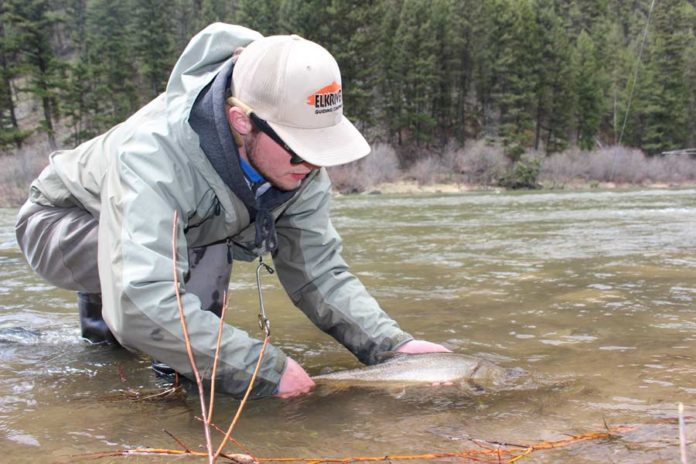Written by: Patrick Blackdale, Willowfly Anglers
Protecting a trout after you’ve brought it to the next can help ensure that it survives to fight another day.
Photos by Patrick Blackdale
Few things are more exciting that catching a big fish, but it’s important that you keep your head at the point when that fish is most vulnerable. Keeping our fisheries healthy and thriving is a team effort that begins with anglers on the stream. Science has proven that catch-and-release fishing can produce high survival rates–but only if good C&R protocols are performed properly. Here are five tips to ensure healthy releases.
- Beef up your tackle. Use tackle that is heavy enough to play a fish quickly without exhausting it. Extremely light tackle may seem sportier, but it usually isn’t necessary and ends up causing excessively long fights. Always try to bring the fish to net as quickly as you can.
- Go Barbless. Whether you buy flies or tie your own, pinching down the barb of the hooks before they make it into your fly box is a great habit. A barbless hook comes out of a fish in the net (or your shirt) with ease, eliminating time-consuming fly retrieval. This allows you to remove hooks quickly with a hemostat without even handling the fish.
- Keep ’em wet. Imagine running a mile and then holding your breath immediately after crossing the finish line. This is what a trout goes through if you remove it from the water after netting the fish. Trout need to remain in the water to revive from the trauma of the fight.
- Photos: make them quick! Keep the fish submerged in the net until the camera and photographer are in place and ready to snap the photo. Wet your hands gently, cradling the fish by the belly and the “wrist” of the tail. Do not squeeze the fish, and don’t touch the delicate gills, mouth, or eyes . Simply hold the fish up quickly for a photo and return it to the water. The fish should not be out of the water for more than five seconds.
- Revive the fish slowly. Gently hold the fish facing upstream in a mellow current. Wait for the fish to swim out of your hands under its own power. Don’t move the fish vigorously forward and back, as this does not allow the gills to function properly.

Keep the fish in the net as much as possible–while you remove the hook and wait for your buddy to get the camera ready.

The Keep ‘Em Wet ethos can help us maintain healthy fisheries into the future.
With more and more people fly fishing around the country, it is more imperative than ever to practice these techniques. Hopefully with these easy tips you will feel more confident in releasing healthy fish back into the river to be caught another day!
Patrick Blackdale is the Assistant Outfitting Manager and a fly fishing guide at Three Rivers Resort in Almont, Colorado. Willowfly Anglers is the guide service at Three Rivers Resort.
Credit: Source link






























